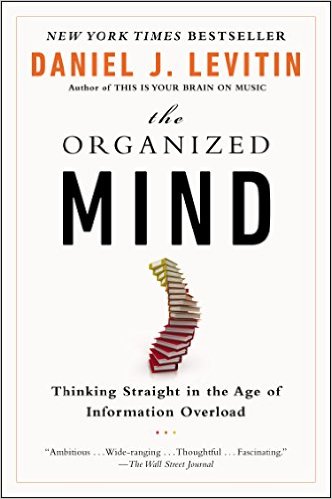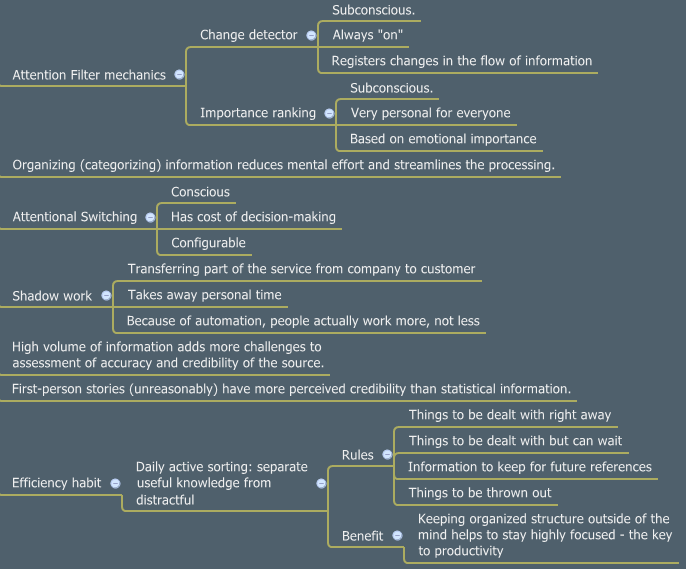Manage Focus Of Your Attention
These are the points I captured while reading 2nd part of “Too much information, too many decisions” chapter of the book “The Organized Mind: Thinking Straight in the Age of Information Overload” by Dr. Daniel J. Levitin. I put my points and cross-references next to them.
- Attention Filter mechanics
- Change detector
- Subconscious.
- Always “on”
- Registers changes in the flow of information
- Importance ranking
- Subconscious.
- Very personal for everyone
- Based on emotional importance
- Change detector
|| Knowing this mechanics it’s easy to understand why colored, bright images draw more attention, as well as “fear – solution” based advertisements.
|| This is exactly why long plain boring test reports are so.. well, boring. No one wants to read them because it requires a significant mental effort to focus and understand. Everyone is busy and overloaded, so it’s excusable. Good testing must include quality reporting to ensure that the information catches the readers’ attention and perceived as important according to our efforts.
|| Coming reference: visualizing testing.
- Organizing (categorizing) information reduces mental effort and streamlines the processing.
|| In testing, I found best working for me to have blurry (heuristic?) categories. Many concepts tend to “bleed into each other”, and many qualities are a) subjective b) have different importance from the different angles.
|| Yet, setting the direction helps to remember and apply quickly, and to guide the process. For example, at some point I started to take notes on different events I’m attending. At first, it was a stream of entries on different aspects, but then I reviewed my journal and noticed a pattern. I made it into a mnemonic and use PACE COLT since then.
- Attentional Switching
- Conscious
- Has cost of decision-making
- Configurable
|| Attentional switching has a cost! Multi-tasking, so much endorsed is a productivity killer. I’m a big proponent of focused work sessions, and plan my day with time slots blocked for those (described in the previous part).
|| Any little thing that causes switching has a negative impact. An email dropping into inbox, a phone call. Even a need to copy hyperlink for the reference in my text distracts me from my flow of thoughts. Getting back “into the zone” might be long or not possible at all.
|| At the same time, upon finishing of the session, switching to another type of activity – a walk, talk to another person, helps to “unload” the mind and prepare for another focused session.
- Shadow work
- Transferring part of the service from company to customer
- Takes away personal time
- Because of automation, people actually work more, not less
|| I for the first time learned of this concept – shadow work – while reading the book.
|| I recalled a very skillfully told customer experience report once posted by Michael Bolton.
|| Coming references: shadow work in testing. Part 1. Part2.
|| “Because of automation, people actually work more, not less”. This seemed to me odd, at first. Don’t we automate tasks to accomplish more by doing something else? After all, I (sometimes) do a lot of task automation in testing (what I used to call “test automation” before). But then it made sense. Automation performs something; yes. But it is for people, must be triggered (sometimes, also guided) by people, and people have to review it and make decisions. Automation is inflexible – so it forces people to adapt for it’s hard-coded process and struggle when it gets stuck. Automation is irresponsible, so it doesn’t have to worry, but people do, and they now have to worry for the parts they don’t control.
- High volume of information adds more challenges to assessment of accuracy and credibility of the source.
|| In Testing: high number of unfixed bugs makes it harder to access the quality, and to test further – checking whether the bug has been opened already is a kind of shadow work.
- First-person stories (unreasonably) have more perceived credibility than statistical information.
|| In Testing: this can and should be used for the advantage – telling testing story to our customers brings facts together and helps to understand the whole picture.
- Efficiency habit
- Daily active sorting: separate useful knowledge from distractful
- Rules
- Things to be dealt with right away
- Things to be dealt with but can wait
- Information to keep for future references
- Things to be thrown out
- Benefit
- Keeping organized structure outside of the mind helps to stay highly focused – the key to productivity
- Rules
- Daily active sorting: separate useful knowledge from distractful
|| I’ve been applying somewhat like this concept for a while now.
|| I use tabs in my GMail to prioritize and categorize work items. I label and archive emails that are “for future references”.
|| I have multiple pages in my notebook for different categories, and I use color-coding within the categories to highlight more important tasks.
|| I indeed found that writing down a task de-clutters my mind and even makes feeling better. Putting a trouble into the list somehow makes me feel like I’ve started dealing with it already!




